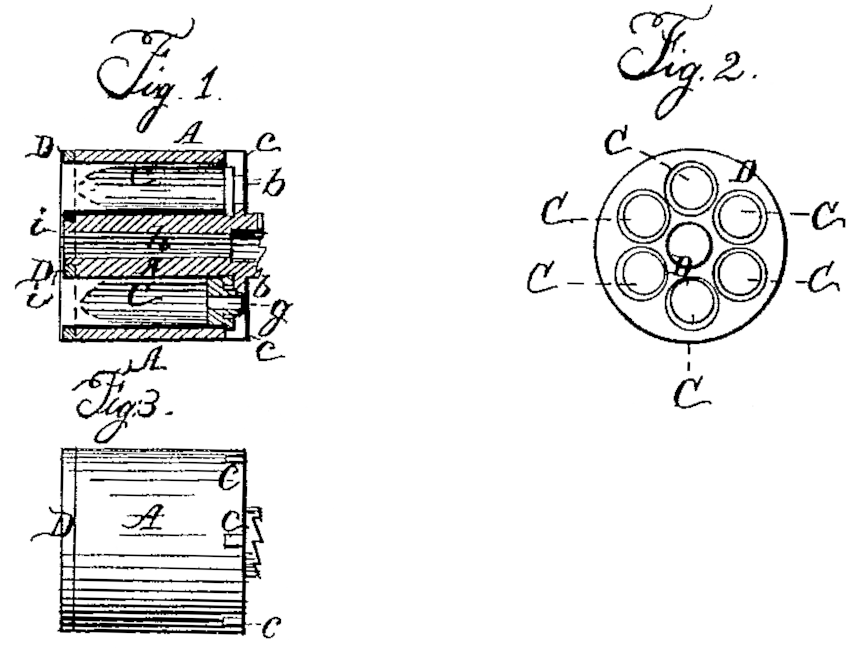US 38934
UNITED STATES PATENT OFFICE.
LUCIUS. W. POND, OF WORCESTER, MASSACHUSETTS, ASSIGNOR TO HIMSELF AND JOHN H. VICKERS, OF SAME PLACE.
IMPROVEMENT IN REVOLVING FIRE-ARMS.
Specification forming part of Letters Patent No. 38,934, dated June 16, 1863.
To all whom it may concern:
Be it known that I, Lucius W. Pond, of the city of Worcester, in the county of Worcester and State of Massachusetts, have invented a new and useful Improvement in Revolving Fire-Arms; and I do hereby declare that the following is a full, clear, and exact description of the same, reference being had to the accompanying drawings, forming part of this specification.
This invention relates to the employment in the chambers of revolving fire-arms of the lining thimbles or tubes which constitute the subject-matter of a previous application made by John H. Wickers and myself; and it consists in so connecting such thimbles or tubes together at their front ends, by means of a ring or flange fitting to or against the front of the cylinder, that they can all be withdrawn from or inserted into their respective chambers at once, thereby greatly expediting the operation of loading.
Figure 1 in the drawings is a central longitudinal section of a cylinder having my invention applied. Fig. 2 is a back view of the ring or flange, with the lining thimbles or tubes attached. Fig. 3 is a side view of the same.
Similar letters of reference indicate corresponding parts in the several figures.
A is the cylinder, constructed precisely in the manner described in the previous application hereinbefore mentioned— that is to say, with its chambers of a caliber large enough for the passage of the flanges of the cartridges, and with smaller central openings, b b, and slots c c in the backs of the said chambers.
C C are the lining-tubes, constructed as described in the application aforesaid, except that, instead of being furnished each with a separate flange at its front end, they are all fitted and permanently secured at their front ends, by riveting or otherwise, into holes provided for their reception in a ring, D, of steel or other metal, said ring forming one flange for the whole of the said thimbles or tubes, and holding them parallel with each other in such positions that when any one is opposite to and concentric with any chamber the others may be exactly opposite to and concentric with other chambers, and consequently that they may be inserted all at once into the several chambers, one into each chamber. The said ring or flange may have an external diameter corresponding with that of the cylinder, and its outer periphery may be milled to enable it to be better taken hold of to draw the lining thimbles or tubes from the chambers. The inner diameter of the said ring or flange may correspond with the external diameter of an annular projection, i, formed around the central bore, h, of the cylinder, which receives the axis-pin. Its back is formed to fit snugly against the front end of the cylinder.
To permit the withdrawal of the thimbles for loading the arm with the metallic cartridges, the cylinder mast be either withdrawn from the frame, or the frame must be opened in such manner as to uncover the whole front end of the cylinder. To load, the lining tubes or thimbles are all withdrawn together by taking hold of the ring or flange D and drawing it away from the cylinder, and the cartridges are inserted or dropped into the front end of cylinder, after which the thimbles or tubes are inserted together into the chambers from the front end of the cylinder.
It is obvious that by the removal and insertion of the whole of the lining thimbles or tubes at once much time must be saved in loading and reloading. The ring or flange has also the advantage of keeping the lining thimbles or tubes together, and so preventing the loss of any of them.
To provide for loading with loose powder and ball, I propose to provide the several lining tubes or thimbles with nipples g, constructed and applied and to be used as described with reference to the detached or independent lining tubes or thimbles previously referred to.
What I claim as my invention, and desire to secure by Letters Patent, is—
The connection of the several lining thimbles or tubes C C at their front ends by means of a ring or flange, D, substantially as and for the purpose herein specified.
LUCIUS W. POND.
Witnesses:
George Swan,
Stephen P. Miss.

